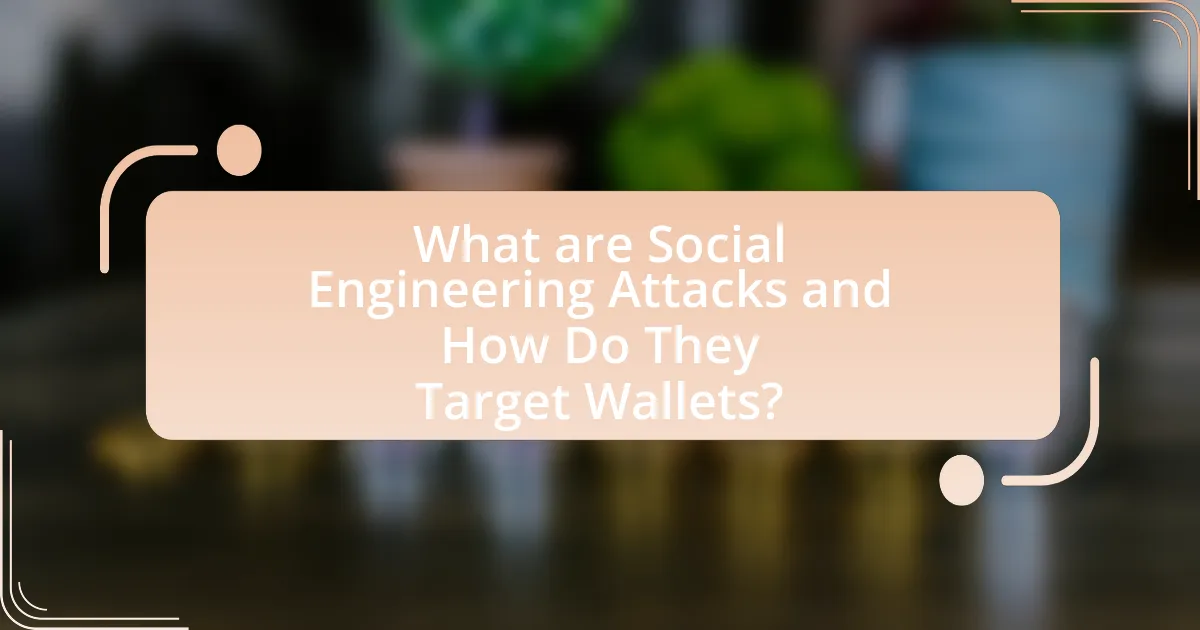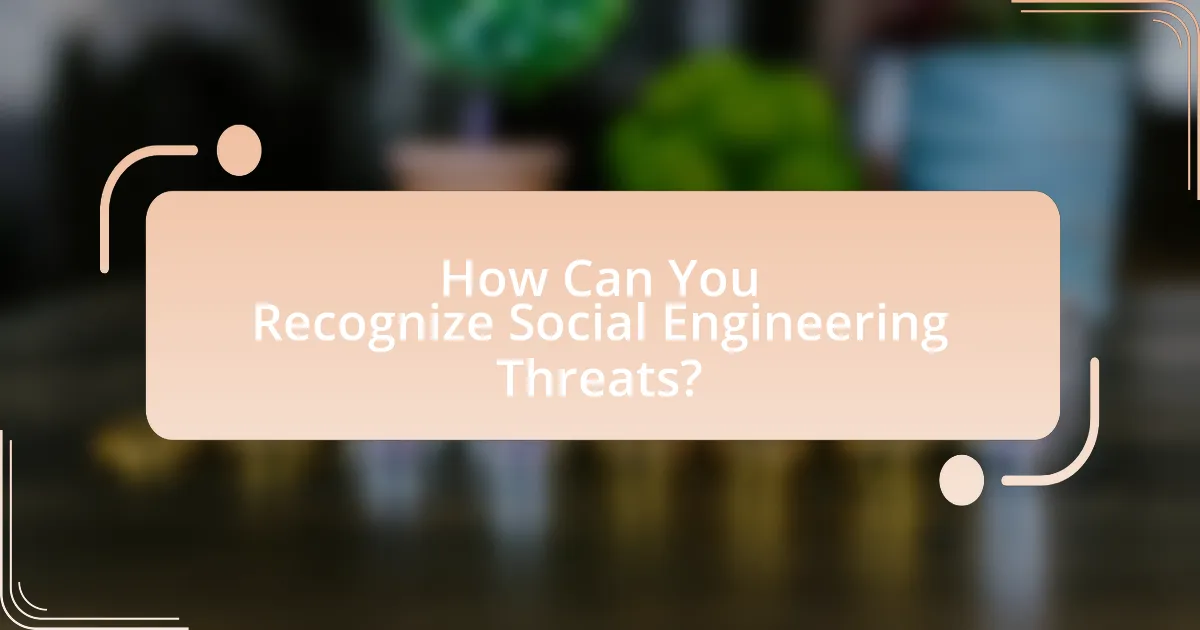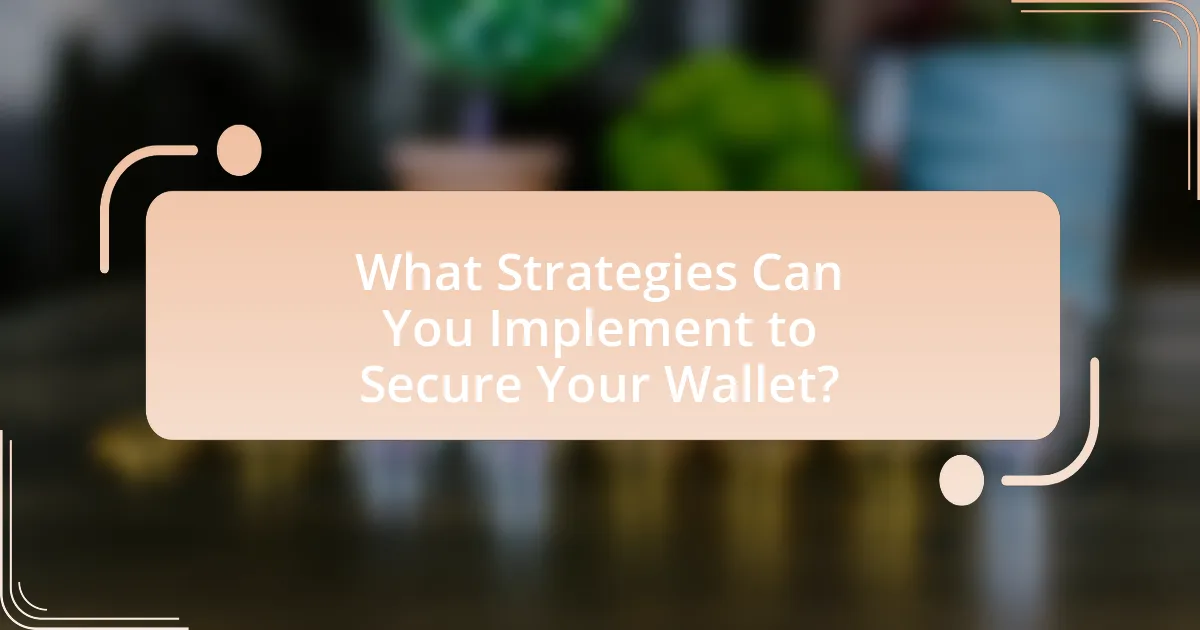Social engineering attacks are manipulative tactics employed by cybercriminals to deceive individuals into revealing confidential information, particularly targeting digital wallets. This article explores the various methods used in these attacks, including phishing, pretexting, baiting, and vishing, and highlights the psychological tactics that make them effective. It emphasizes the importance of awareness and education in recognizing potential threats and provides practical strategies for securing wallets, such as implementing multi-factor authentication, using strong passwords, and employing security tools. Additionally, the article outlines best practices for responding to suspicious communications and maintaining wallet security against social engineering threats.

What are Social Engineering Attacks and How Do They Target Wallets?
Social engineering attacks are manipulative tactics used by cybercriminals to deceive individuals into divulging confidential information, often targeting digital wallets. These attacks exploit human psychology rather than technical vulnerabilities, employing methods such as phishing emails, fake websites, and social media impersonation to trick users into providing access to their wallets or sensitive data. For instance, a report from the Anti-Phishing Working Group indicates that phishing attacks have increased significantly, with over 200,000 unique phishing sites reported in a single quarter, many of which specifically aim to steal cryptocurrency wallet credentials.
How do social engineering attacks manipulate individuals?
Social engineering attacks manipulate individuals by exploiting psychological principles to gain unauthorized access to sensitive information. These attacks often involve tactics such as deception, persuasion, and emotional manipulation, leading victims to disclose personal data or perform actions that compromise their security. For instance, attackers may impersonate trusted figures or create a sense of urgency, prompting individuals to act without critical thinking. Research indicates that approximately 98% of cyberattacks involve some form of social engineering, highlighting the effectiveness of these manipulative strategies in breaching security.
What psychological tactics are commonly used in these attacks?
Psychological tactics commonly used in social engineering attacks include manipulation, urgency, and authority. Manipulation involves exploiting emotions such as fear or trust to influence decisions, as seen in phishing scams where attackers pose as trusted entities. Urgency creates pressure, compelling victims to act quickly without thorough consideration, often leading to hasty decisions that compromise security. Authority tactics leverage perceived power, where attackers impersonate figures of authority to gain compliance, as evidenced by cases where fraudsters mimic IT personnel to extract sensitive information. These tactics are effective because they exploit human psychology, making individuals more susceptible to deception.
How can attackers gather information about their targets?
Attackers can gather information about their targets through various methods, including social engineering, online reconnaissance, and data breaches. Social engineering techniques involve manipulating individuals into divulging confidential information, often through phishing emails or phone calls. Online reconnaissance includes searching social media profiles, public records, and forums to collect personal details. Data breaches expose sensitive information, which attackers can exploit to gain insights into their targets. For instance, the 2017 Equifax breach compromised the personal data of approximately 147 million people, illustrating how attackers can leverage such incidents to gather information.
What types of social engineering attacks can affect wallets?
Phishing attacks, pretexting, baiting, and vishing are types of social engineering attacks that can affect wallets. Phishing involves tricking individuals into providing sensitive information through deceptive emails or websites, often targeting wallet credentials. Pretexting occurs when an attacker creates a fabricated scenario to obtain personal information, which can lead to unauthorized access to wallets. Baiting involves enticing victims with promises of free items or services to lure them into revealing wallet details. Vishing, or voice phishing, uses phone calls to manipulate individuals into disclosing sensitive information related to their wallets. These methods exploit human psychology, making them effective in compromising wallet security.
What is phishing and how does it compromise wallet security?
Phishing is a cyber attack that involves tricking individuals into providing sensitive information, such as passwords or private keys, often through deceptive emails or websites. This type of attack compromises wallet security by enabling attackers to gain unauthorized access to cryptocurrency wallets, leading to the theft of funds. According to the Anti-Phishing Working Group, there were over 200,000 reported phishing attacks in the first quarter of 2021 alone, highlighting the prevalence and effectiveness of such tactics in compromising digital assets.
How do pretexting and baiting work in the context of wallet security?
Pretexting and baiting are social engineering tactics that exploit human psychology to compromise wallet security. Pretexting involves creating a fabricated scenario to obtain sensitive information, such as pretending to be a bank representative to extract wallet credentials. This method relies on the victim’s trust and willingness to share personal data. Baiting, on the other hand, entices individuals with a promise of a reward, such as free software or cryptocurrency, leading them to download malicious software that compromises wallet security. Both tactics highlight the importance of vigilance and skepticism in protecting digital assets, as attackers often leverage emotional triggers to bypass security measures.

How Can You Recognize Social Engineering Threats?
You can recognize social engineering threats by identifying suspicious behaviors, such as unsolicited requests for sensitive information or unusual communication methods. These threats often involve manipulation tactics, where attackers create a sense of urgency or fear to prompt quick responses. For instance, a common tactic is phishing emails that appear legitimate but contain links to fraudulent websites. According to the Anti-Phishing Working Group, there were over 200,000 reported phishing attacks in 2020 alone, highlighting the prevalence of such threats. Recognizing these signs can help individuals protect themselves from potential scams and unauthorized access to their personal information.
What signs indicate a potential social engineering attack?
Signs that indicate a potential social engineering attack include unsolicited communication requesting sensitive information, urgency in the request, and inconsistencies in the sender’s identity or message. For instance, attackers often create a sense of urgency to prompt quick responses, such as claiming an account will be locked unless immediate action is taken. Additionally, phishing emails may contain poor grammar or unusual sender addresses, which can signal a fraudulent attempt. Recognizing these signs is crucial, as studies show that 97% of people cannot identify a phishing email, highlighting the importance of vigilance in communication.
How can you identify suspicious communication methods?
To identify suspicious communication methods, look for inconsistencies in the sender’s identity, unusual requests for personal information, and poor grammar or spelling. These indicators often signal phishing attempts or social engineering tactics. For instance, legitimate organizations typically do not ask for sensitive information via email or text. According to the Anti-Phishing Working Group, phishing attacks increased by 220% in 2020, highlighting the prevalence of such tactics. Recognizing these signs can help individuals protect themselves against potential scams.
What red flags should you look for in unsolicited requests?
Red flags to look for in unsolicited requests include poor grammar and spelling, which often indicate a lack of professionalism and authenticity. Additionally, requests that create a sense of urgency or pressure the recipient to act quickly are suspicious, as they are common tactics used in social engineering attacks. Furthermore, unsolicited requests that ask for sensitive information, such as passwords or financial details, should be treated with caution, as legitimate organizations typically do not request such information via email or messages. Lastly, requests from unknown senders or those that use generic greetings instead of personal names can signal potential scams.
Why is awareness crucial in preventing social engineering attacks?
Awareness is crucial in preventing social engineering attacks because it equips individuals with the knowledge to recognize and respond to deceptive tactics used by attackers. Social engineering relies on manipulating human psychology, and informed individuals are less likely to fall victim to scams, such as phishing or pretexting. Research indicates that organizations with regular security awareness training experience a 70% reduction in successful social engineering attacks, demonstrating the effectiveness of awareness in mitigating risks.
How does understanding social engineering tactics enhance personal security?
Understanding social engineering tactics enhances personal security by equipping individuals with the knowledge to recognize and mitigate manipulation attempts. By being aware of common techniques such as phishing, pretexting, and baiting, individuals can identify suspicious communications and avoid falling victim to scams. Research indicates that 97% of people cannot identify a phishing email, highlighting the importance of education in recognizing these tactics. This awareness leads to proactive measures, such as verifying sources and safeguarding personal information, ultimately reducing the risk of unauthorized access to sensitive data and financial loss.
What role does education play in recognizing threats?
Education plays a crucial role in recognizing threats by equipping individuals with the knowledge and skills necessary to identify potential risks and deceptive tactics used in social engineering attacks. Through educational programs, individuals learn about common strategies employed by attackers, such as phishing, pretexting, and baiting, which enhances their ability to discern suspicious activities. Research indicates that organizations that implement regular training on cybersecurity awareness see a significant reduction in successful social engineering attacks, with a study by the Ponemon Institute revealing that companies with comprehensive security training programs experience 50% fewer breaches. This evidence underscores the importance of education in fostering a proactive mindset towards threat recognition and response.

What Strategies Can You Implement to Secure Your Wallet?
To secure your wallet against social engineering attacks, implement multi-factor authentication (MFA) for all accounts linked to your wallet. MFA adds an extra layer of security by requiring not only a password but also a second form of verification, such as a text message or authentication app code. According to a study by Google, MFA can block 99.9% of automated attacks, significantly reducing the risk of unauthorized access. Additionally, regularly update your wallet software and use strong, unique passwords for each account to further enhance security.
How can you strengthen your wallet’s security against social engineering?
To strengthen your wallet’s security against social engineering, implement multi-factor authentication (MFA) for all transactions. MFA adds an additional layer of security by requiring not only a password but also a second form of verification, such as a text message code or biometric scan. According to a study by the Cybersecurity & Infrastructure Security Agency, using MFA can block up to 99.9% of automated attacks, significantly reducing the risk of unauthorized access to your wallet.
What best practices should you follow for password management?
To effectively manage passwords, utilize unique, complex passwords for each account, incorporating a mix of letters, numbers, and symbols. This practice significantly reduces the risk of unauthorized access, as studies show that 81% of data breaches are linked to weak or stolen passwords. Additionally, implement two-factor authentication (2FA) wherever possible, as it adds an extra layer of security by requiring a second form of verification. Regularly update passwords and avoid reusing them across different sites to further enhance security. Using a reputable password manager can also help in generating and storing complex passwords securely.
How can two-factor authentication enhance your wallet’s security?
Two-factor authentication (2FA) enhances your wallet’s security by requiring an additional verification step beyond just a password. This additional layer significantly reduces the risk of unauthorized access, as even if a password is compromised, the attacker would still need the second factor, typically a code sent to a mobile device or generated by an authentication app. According to a study by Google, implementing 2FA can block 99.9% of automated attacks, demonstrating its effectiveness in protecting sensitive information and assets in digital wallets.
What tools and technologies can help protect your wallet?
To protect your wallet, tools and technologies such as hardware wallets, encryption software, and two-factor authentication (2FA) are essential. Hardware wallets, like Ledger and Trezor, store cryptocurrencies offline, significantly reducing the risk of online hacks. Encryption software, such as VeraCrypt, secures sensitive information by converting it into unreadable formats, ensuring that even if data is intercepted, it remains protected. Two-factor authentication adds an extra layer of security by requiring a second form of verification, such as a text message or authentication app, before granting access to wallet accounts. These technologies collectively enhance wallet security against social engineering attacks by making unauthorized access more difficult.
How do security software and applications contribute to wallet safety?
Security software and applications enhance wallet safety by providing real-time protection against malware, phishing attacks, and unauthorized access. These tools employ advanced algorithms to detect and neutralize threats, ensuring that sensitive information, such as private keys and passwords, remains secure. For instance, antivirus programs can identify malicious software that targets wallet applications, while firewalls can block unauthorized network access. Additionally, two-factor authentication (2FA) integrated into wallet applications adds an extra layer of security, making it significantly harder for attackers to gain access. According to a report by Cybersecurity Ventures, cybercrime is projected to cost the world $10.5 trillion annually by 2025, highlighting the critical need for robust security measures in protecting digital wallets.
What features should you look for in a secure wallet solution?
A secure wallet solution should include features such as strong encryption, two-factor authentication, and backup recovery options. Strong encryption protects sensitive data from unauthorized access, while two-factor authentication adds an extra layer of security by requiring a second form of verification. Backup recovery options ensure that users can regain access to their funds in case of device loss or failure. According to a report by the Cybersecurity & Infrastructure Security Agency, wallets with these features significantly reduce the risk of unauthorized access and enhance overall security against social engineering attacks.
What are the best practices for responding to potential threats?
The best practices for responding to potential threats include immediate identification, assessment, and mitigation of the threat. First, individuals should recognize suspicious activities or communications, such as unsolicited messages requesting personal information. Next, assessing the credibility of the threat involves verifying the source and context of the communication. For instance, if a message claims to be from a bank but uses a generic email address, it should be treated as a potential phishing attempt. Finally, mitigation strategies include reporting the threat to relevant authorities, such as financial institutions or cybersecurity teams, and implementing security measures like changing passwords and enabling two-factor authentication. These practices are supported by cybersecurity guidelines from organizations like the Cybersecurity and Infrastructure Security Agency (CISA), which emphasize the importance of vigilance and proactive responses to threats.
How should you handle suspicious communications regarding your wallet?
To handle suspicious communications regarding your wallet, immediately cease any interaction and do not provide personal information. This approach is crucial because many scams involve phishing attempts that aim to steal sensitive data. For instance, according to the Anti-Phishing Working Group, there were over 200,000 reported phishing attacks in 2020 alone, highlighting the prevalence of such threats. Additionally, verify the legitimacy of the communication by contacting the organization directly through official channels, rather than using any contact information provided in the suspicious message. This method ensures that you are not engaging with potential fraudsters.
What steps should you take if you suspect a social engineering attack?
If you suspect a social engineering attack, immediately cease all communication with the suspected attacker. This step is crucial as it prevents further manipulation or information leakage. Next, report the incident to your organization’s IT or security team, as they can investigate and mitigate potential threats. Additionally, change your passwords and enable two-factor authentication on your accounts to enhance security. Document all details of the interaction, including dates, times, and the nature of the communication, as this information can assist in the investigation. According to the Cybersecurity & Infrastructure Security Agency, timely reporting and documentation are essential in responding effectively to social engineering threats.
What practical tips can help you maintain wallet security?
To maintain wallet security, regularly update your passwords and enable two-factor authentication. Strong, unique passwords reduce the risk of unauthorized access, while two-factor authentication adds an extra layer of protection by requiring a second form of verification. According to a study by Google, two-factor authentication can block 100% of automated bots and 96% of phishing attacks, significantly enhancing security. Additionally, avoid sharing sensitive information and be cautious of unsolicited communications that may attempt to extract personal details.